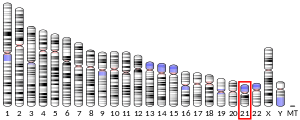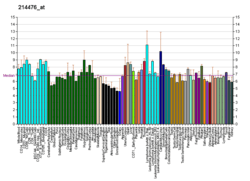Trefoil factor 2
Trefoil factor 2 is a protein that in humans is encoded by the TFF2 gene.[5][6][7]
| TFF2 | |||||||||||||||||||||||||
|---|---|---|---|---|---|---|---|---|---|---|---|---|---|---|---|---|---|---|---|---|---|---|---|---|---|
| |||||||||||||||||||||||||
| Identifiers | |||||||||||||||||||||||||
| Aliases | TFF2, SML1, SP, trefoil factor 2 | ||||||||||||||||||||||||
| External IDs | OMIM: 182590 MGI: 1306805 HomoloGene: 3956 GeneCards: TFF2 | ||||||||||||||||||||||||
| |||||||||||||||||||||||||
| |||||||||||||||||||||||||
| |||||||||||||||||||||||||
| |||||||||||||||||||||||||
| Orthologs | |||||||||||||||||||||||||
| Species | Human | Mouse | |||||||||||||||||||||||
| Entrez | |||||||||||||||||||||||||
| Ensembl | |||||||||||||||||||||||||
| UniProt | |||||||||||||||||||||||||
| RefSeq (mRNA) | |||||||||||||||||||||||||
| RefSeq (protein) | |||||||||||||||||||||||||
| Location (UCSC) | Chr 21: 42.35 – 42.35 Mb | Chr 17: 31.14 – 31.14 Mb | |||||||||||||||||||||||
| PubMed search | [3] | [4] | |||||||||||||||||||||||
| Wikidata | |||||||||||||||||||||||||
| |||||||||||||||||||||||||
Members of the trefoil family are characterized by having at least one copy of the trefoil motif, a 40-amino acid domain that contains three conserved disulfides. They are stable secretory proteins expressed in gastrointestinal mucosa. Their functions are not defined, but they may protect the mucosa from insults, stabilize the mucus layer and affect healing of the epithelium. The encoded protein inhibits gastric acid secretion. This gene and two other related trefoil family member genes are found in a cluster on chromosome 21.[7]
Glycan binding
All human trefoil factors are lectins that interact specifically with the disaccharide GlcNAc-α-1,4-Gal.[8] This disaccharide is an unusual glycotope that is only known to exist on the large, heavily glycosylated, mucins in the mucosa. By cross-linking mucins through the bivalent binding of this glycotope, the trefoil factors are then able to reversible modulate the thickness and viscosity of the mucus.[8]
References
- GRCh38: Ensembl release 89: ENSG00000160181 - Ensembl, May 2017
- GRCm38: Ensembl release 89: ENSMUSG00000024028 - Ensembl, May 2017
- "Human PubMed Reference:". National Center for Biotechnology Information, U.S. National Library of Medicine.
- "Mouse PubMed Reference:". National Center for Biotechnology Information, U.S. National Library of Medicine.
- Tomasetto C, Rockel N, Mattei MG, Fujita R, Rio MC (Sep 1992). "The gene encoding the human spasmolytic protein (SML1/hSP) is in 21q 22.3, physically linked to the homologous breast cancer marker gene BCEI/pS2". Genomics. 13 (4): 1328–30. doi:10.1016/0888-7543(92)90059-2. PMID 1505966.
- Gott P, Beck S, Machado JC, Carneiro F, Schmitt H, Blin N (May 1997). "Human trefoil peptides: genomic structure in 21q22.3 and coordinated expression". Eur J Hum Genet. 4 (6): 308–15. doi:10.1159/000472224. PMID 9043862.
- "Entrez Gene: TFF2 trefoil factor 2 (spasmolytic protein 1)".
- Järvå MA, Lingford JP, John A, Soler NM, Scott NE, Goddard-Borger ED (May 2020). "Trefoil factors share a lectin activity that defines their role in mucus". Nature Communications. 11 (1): 2265. doi:10.1038/s41467-020-16223-7. PMC 7221086. PMID 32404934.
Further reading
- Advenier C, Lagente V, Boichot E (1997). "The role of tachykinin receptor antagonists in the prevention of bronchial hyperresponsiveness, airway inflammation and cough". Eur. Respir. J. 10 (8): 1892–906. doi:10.1183/09031936.97.10081892. PMID 9272936.
- Langer G, Jagla W, Behrens-Baumann W, et al. (2003). "Ocular TFF-peptides: new mucus-associated secretory products of conjunctival goblet cells". Adv. Exp. Med. Biol. 506 (Pt A): 313–6. doi:10.1007/978-1-4615-0717-8_44. PMID 12613926.
- Tomasetto C, Rio MC, Gautier C, et al. (1990). "hSP, the domain-duplicated homolog of pS2 protein, is co-expressed with pS2 in stomach but not in breast carcinoma". EMBO J. 9 (2): 407–14. PMC 551681. PMID 2303034.
- Bhogal N, Donnelly D, Findlay JB (1994). "The ligand binding site of the neurokinin 2 receptor. Site-directed mutagenesis and identification of neurokinin A binding residues in the human neurokinin 2 receptor". J. Biol. Chem. 269 (44): 27269–74. PMID 7961636.
- Hanby AM, Poulsom R, Singh S, et al. (1993). "Spasmolytic polypeptide is a major antral peptide: distribution of the trefoil peptides human spasmolytic polypeptide and pS2 in the stomach". Gastroenterology. 105 (4): 1110–6. PMID 8405856.
- Itoh H, Tomita M, Uchino H, et al. (1996). "cDNA cloning of rat pS2 peptide and expression of trefoil peptides in acetic acid-induced colitis". Biochem. J. 318 (3): 939–44. PMC 1217708. PMID 8836141.
- May FE, Westley BR (1997). "Close physical linkage of the genes encoding the pNR-2/pS2 protein and human spasmolytic protein (hSP)". Hum. Genet. 99 (3): 303–7. doi:10.1007/s004390050362. PMID 9050913.
- Seib T, Blin N, Hilgert K, et al. (1997). "The three human trefoil genes TFF1, TFF2, and TFF3 are located within a region of 55 kb on chromosome 21q22.3". Genomics. 40 (1): 200–2. doi:10.1006/geno.1996.4511. PMID 9070946.
- Kayademir T, Silva Edos S, Pusch C, et al. (1998). "A novel 25 bp tandem repeat within the human trefoil peptide gene TFF2 in 21q22.3: polymorphism and mammalian evolution". Eur. J. Hum. Genet. 6 (2): 121–8. doi:10.1038/sj.ejhg.5200166. PMID 9781055.
- Brunelleschi S, Bordin G, Colangelo D, Viano I (1999). "Tachykinin receptors on human monocytes: their involvement in rheumatoid arthritis". Neuropeptides. 32 (3): 215–23. doi:10.1016/S0143-4179(98)90040-3. PMID 10189055.
- May FE, Semple JI, Newton JL, Westley BR (2000). "The human two domain trefoil protein, TFF2, is glycosylated in vivo in the stomach". Gut. 46 (4): 454–9. doi:10.1136/gut.46.4.454. PMC 1727891. PMID 10716671.
- Hattori M, Fujiyama A, Taylor TD, et al. (2000). "The DNA sequence of human chromosome 21". Nature. 405 (6784): 311–9. doi:10.1038/35012518. PMID 10830953.
- Berry A, Scott HS, Kudoh J, et al. (2001). "Refined localization of autosomal recessive nonsyndromic deafness DFNB10 locus using 34 novel microsatellite markers, genomic structure, and exclusion of six known genes in the region". Genomics. 68 (1): 22–9. doi:10.1006/geno.2000.6253. PMID 10950923.
- Bulitta CJ, Fleming JV, Raychowdhury R, et al. (2002). "Autoinduction of the trefoil factor 2 (TFF2) promoter requires an upstream cis-acting element". Biochem. Biophys. Res. Commun. 293 (1): 366–74. doi:10.1016/S0006-291X(02)00199-7. PMID 12054609.
- Strausberg RL, Feingold EA, Grouse LH, et al. (2003). "Generation and initial analysis of more than 15,000 full-length human and mouse cDNA sequences". Proc. Natl. Acad. Sci. U.S.A. 99 (26): 16899–903. Bibcode:2002PNAS...9916899M. doi:10.1073/pnas.242603899. PMC 139241. PMID 12477932.
- Hu GY, Yu BP, Dong WG, et al. (2003). "Expression of TFF2 and Helicobacter pylori infection in carcinogenesis of gastric mucosa". World J. Gastroenterol. 9 (5): 910–4. PMID 12717829.




